The best MIDI keyboard controller for beginners
Consider this if you want to create your own electronic, rap or dance music tracks.

By Al Griffin
This post was done in partnership with Wirecutter. When readers choose to buy Wirecutter's independently chosen editorial picks, Wirecutter and Engadget may earn affiliate commission. Read the full guide to MIDI keyboard controller for beginners.
After 30 hours of research and hands-on testing, we think the Arturia MiniLab MkII is the best all-around 25-key MIDI keyboard controller for most people looking for an easy, cost-effective way to get into creating electronic music with computers. Arturia's controller is compact enough to fit in a backpack but has solid build quality and an uncluttered design that both beginners and experienced musicians will appreciate.
The Arturia MiniLab MkII has the feel of a professional instrument. The keyboard and pads, though small, are highly responsive and can produce natural sounds from software plug-in instruments right out of the box. While customizing the controller's MIDI functions requires use of a separate app, the MiniLab MkII comes preconfigured to work with most popular computer music-making software, and it's bundled with Arturia's excellent Analog Lab Lite and UVI Grand Piano virtual instrument plug-ins.
The Nektar Impact LX25+ makes a good choice for anyone who might be put off by the Arturia's small size, mini keys, and lack of onboard controls to configure its settings. This model also provides buttons to remotely control music-making software on your computer.
Of all the controllers we tested, the Impact LX25+ proved the best option for live performance—the full-size keys had good action and responsiveness, and the rubber-coated pitch-bend and modulation wheels had a solid feel. The Nektar is the only controller of the bunch that doesn't offer out-of-the-box compatibility with the popular computer music software Ableton Live, but you can still configure it to work with that program.
We recommend the Akai MPK Mini MKII to anyone seeking a compact, portable input device for making beats and triggering samples. The Akai's generously sized pads have a good feel and allow for a decent range of expressiveness when you're finger-drumming. And although the stiff keyboard action makes this model a lesser option for live performance, we found that the thumb-controlled pitch-bend and modulation joystick worked well. Also, the built-in arpeggiator is fun and easy to use, letting you trigger and shape complex synthesizer melodies on the fly.
Why you should trust us
I have two decades of experience reviewing AV products, and currently I am a contributing technical editor at Sound & Vision magazine and a regular contributor to the SoundStage network of websites. I'm also a drummer and electronic-music maker, so I have extensive familiarity with the tools of the trade, including recording interfaces, MIDI controllers, and other gear for desktop studio environments.
For help with the testing phase for this guide, I enlisted Denis Kitchen, a software developer and musician with experience performing and recording with synthesizers and MIDI controllers dating back to the 1980s. As a keyboard player who regularly uses MIDI controllers as part of his live performance rig, Kitchen brought an invaluable hands-on perspective to the evaluation.
Who should buy a keyboard MIDI controller
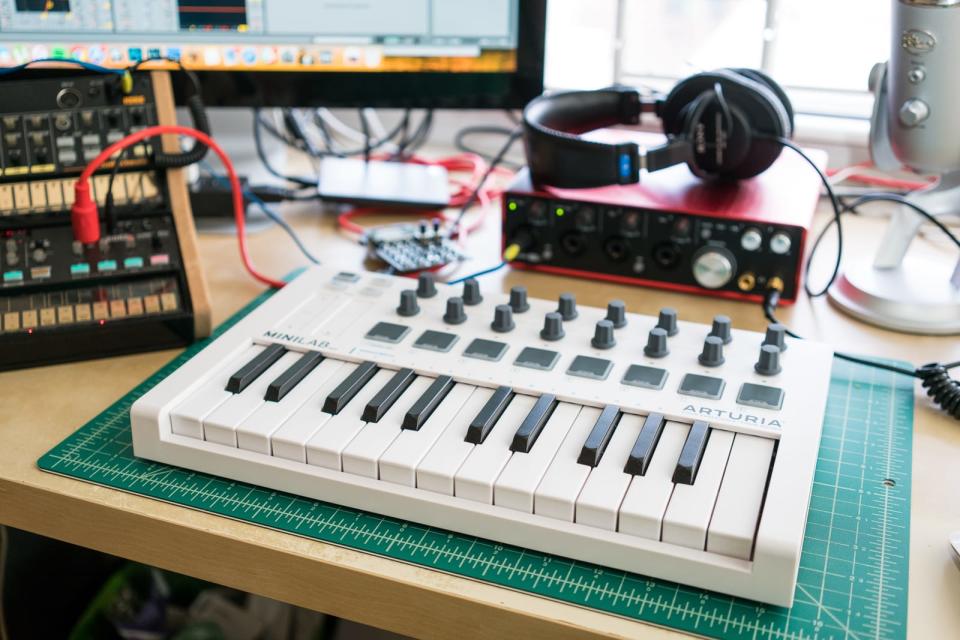
Amateurs who want to create their own electronic, rap, and dance music tracks on a computer will benefit from a keyboard MIDI (Musical Instrument Digital Interface) controller. Making music using MIDI is easy. Aside from the controller, all you need to get started is a DAW (digital audio workstation) software application such as Ableton Live, Apple GarageBand, or Image Line's FL Studio. The controller sends commands to the computer over a USB connection. Those commands then control various aspects of virtual musical instruments that run as plug-ins within the DAW software, playing a piano note soft or loud, for example, or triggering a drum beat.
While available keyboard MIDI controller options include 88-key models that cover the same octave range as a full-size piano, most music makers prefer working with compact, 25-key models that can fit on a desktop. These typically include pads to tap out beats, along with a set of rotary knobs to control things like volume and pitch. While 25-key models cover only a two-octave range, they include controls to "shift" the note range to hit higher and lower octaves. Not only are they desktop-friendly, but most are also small enough for you to stow them in a backpack for easy transport.
Along with providing a compact, portable option for music creation, 25-key controllers are surprisingly affordable. Many models are available for $100 or less, with $150 representing the high-end option. They also typically come bundled with free software, the value of which can easily exceed that of the controller itself. Most controllers include a complimentary license for a Lite version of Ableton Live, a popular DAW that provides a loop-based platform for music composition. Many controllers also come with free software instrument plug-ins that provide authentic-sounding emulations of everything from acoustic grand pianos to vintage analog synthesizers.
Key terms
It's difficult to discuss MIDI controllers and music-production software without spouting off technical jargon. Here's a list of common terms that you'll come across when reading about the category.
MIDI: Musical Instrument Digital Interface is a connection and communication standard that permits computers, keyboards, and drum pads to convey information about note loudness, pitch, and duration back and forth.
DAW: A digital audio workstation is a piece of music-production software for recording, editing, and mixing audio and MIDI tracks.
Virtual instrument: Digital reproductions of musical instruments, virtual instruments can range from classic analog synthesizers and drum machines to soundalikes of acoustic instruments such as piano, violin, and drums. A virtual instrument can run as a stand-alone program or as a plug-in on a digital audio workstation application.
Synth-action: Typically used in synthesizer and some MIDI controller keyboards, synth-action keys are spring-loaded to provide a lighter feel than the weighted action in piano keyboards. While synth-action keys can serve to produce an acoustic piano sound, they are optimized for playing other virtual instruments such as synthesizers.
Velocity: In MIDI, velocity determines the overall loudness of a note or beat. The MIDI velocity range typically covers 127 steps, with the value corresponding to the force with which you strike a key or pad.
Rotary knob: You use this control on a MIDI keyboard to adjust parameters such as loudness, or to "shape" aspects of sounds on software synthesizers by changing elements such as filters, oscillators, and the attack and sustain of notes. Rotary knobs can be either fixed, with a limited range of movement (like a standard volume control with a 0 to 10 range), or endless, with a control range that varies depending on the software.
Pitch-bend wheel: With this control, you vary the pitch and duration of the notes you play on a keyboard.
Modulation wheel: This control varies the tone, vibrato, and other effects of notes you play on a keyboard.
Arpeggiator: Found on MIDI keyboards or synthesizers, an arpeggiator triggers a repeating pattern of notes from a single note or chord. Arpeggiators provide a way to create complex-sounding basslines and melodies by playing only a few notes. They typically also include controls to vary the speed, pattern, and octave range of the notes played.
Automapping: This feature of MIDI controllers enables you to associate, or "map," the software controls in DAWs such as Ableton Live, Apple GarageBand, or FL Studio to corresponding buttons, pads, and knobs on the MIDI controller. This lets you, for example, mute audio tracks by pressing a button or pad on the controller, or adjust their level using a slider or rotary knob.
How we picked
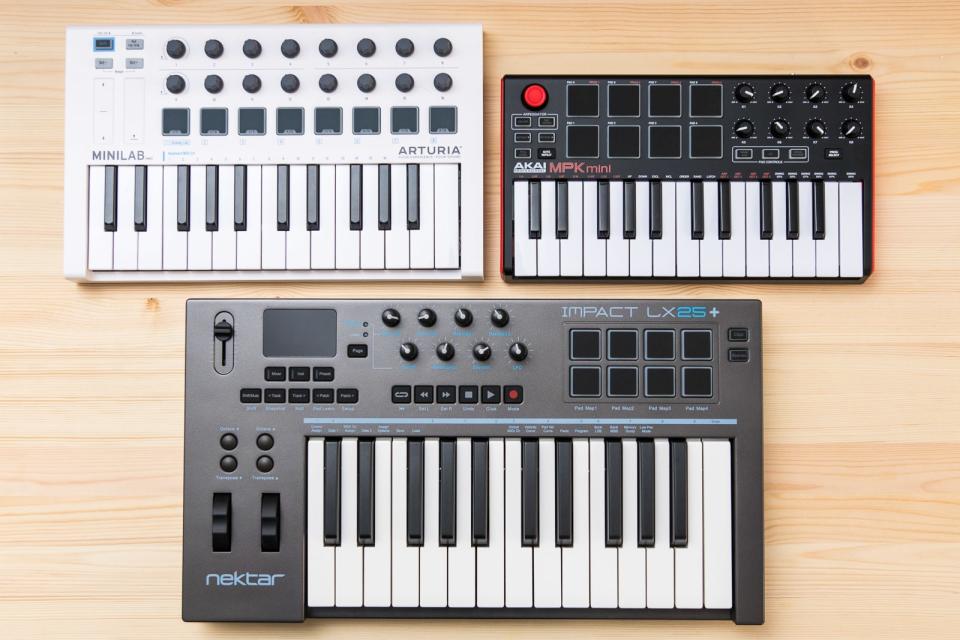
To settle on the keyboard MIDI controllers that I would call in to test, I first read owner reviews on sites including Amazon, Sweetwater, and Musician's Friend. I also scoured professional reviews from magazines, websites, and YouTube channels that specialized in covering MIDI and electronic music production. To pare the category down further, I homed in on the following features:
25 synth-action keys
Multiple pads for drumming and triggering samples
Multiple rotary knobs for on-the-fly adjustment of software instrument parameters
Pitch-bend and modulation controls
Buttons to control DAW-software playback
Preset configurations to control popular DAW software
Quality of bundled software
After making the decision to limit our testing to controllers priced under $150, we settled on six models based on the above list of preferred features: the Akai MPK Mini MkII, Alesis V25, Arturia MiniLab MkII, M-Audio Oxygen 25 MKIV, Nektar Impact LX25+, and Novation Launchkey Mini 25 MK2. The cost for the controllers we tested currently ranges from $90 to $120—a bargain when you consider both the functionality and the free bundled software that some of the models provide.
How we tested
To test the MIDI controllers, I used Ableton Live 9 Lite running on a MacBook Pro. I also downloaded the software instrument plug-ins included with each model to get a sense of their usefulness and value. A free Lite version of Live, a popular loop-based DAW geared for live performance, comes standard with each of the controllers except the Nektar Impact LX25+. (Nektar includes a limited-track version of its own DAW, Bitwig Studio, with that model.) For that reason—and also because I like using Live—it seemed a natural choice for the test, though I also used Apple GarageBand with the Nektar controller to test out its automapping feature.
Dividing up the testing gig—Denis Kitchen on the keyboards, me on the drum pads and general controller features—we evaluated each model by playing and recording music clips and banging out beats. In addition, Kitchen brought a laptop running MainStage 3, a live-performance companion module for Apple's Logic Pro X, so that he could test each controller's capabilities using that software's collection of analog synthesizer patches.
The keyboard qualities that we tested for included playability, a parameter that took into account the weight and springiness of the keys when touched as well as how easy it was to input a melody to the recording software. This was a particular concern for the ultracompact models with mini keys, a group that included the Akai, Arturia, and Novation models. (The other three controllers all featured full-size keys.) Another concern was velocity, or the key's ramp-up to maximum MIDI input value when pressed. In some cases, this parameter allowed adjustments for a more natural feel, either via a setup menu on the keyboard or through an accompanying software app. Finally for keyboards, we tested the performance and ergonomics of the controller's hardware pitch-bend and modulation controls.
The drum pad qualities we tested for included sensitivity and responsiveness—how easy it was to tap out a natural-sounding range of soft to loud drum sounds. Overall feel was also a concern, since the pads on some models had a distinctly harder surface than on others. The pad size and layout ended up being crucial during our test: The small pad size and cramped arrangement on some models made finger-drumming difficult, while the larger, more well-spaced pads on others let us more easily tap out rolls and other fancy drum moves.
We also took note of features that made using each controller easier and more intuitive. This included color-coded pad backlighting, hardware buttons that automapped to corresponding software controls and allowed you to operate the program without touching your computer, and controls that let you configure features such as an arpeggiator, or to switch banks of samples assigned to a specific group of pads. Finally, we checked out the rotary knobs on each unit, looking for qualities such as robustness, resistance, and knob size and spacing.
Our pick: Arturia MiniLab MkII
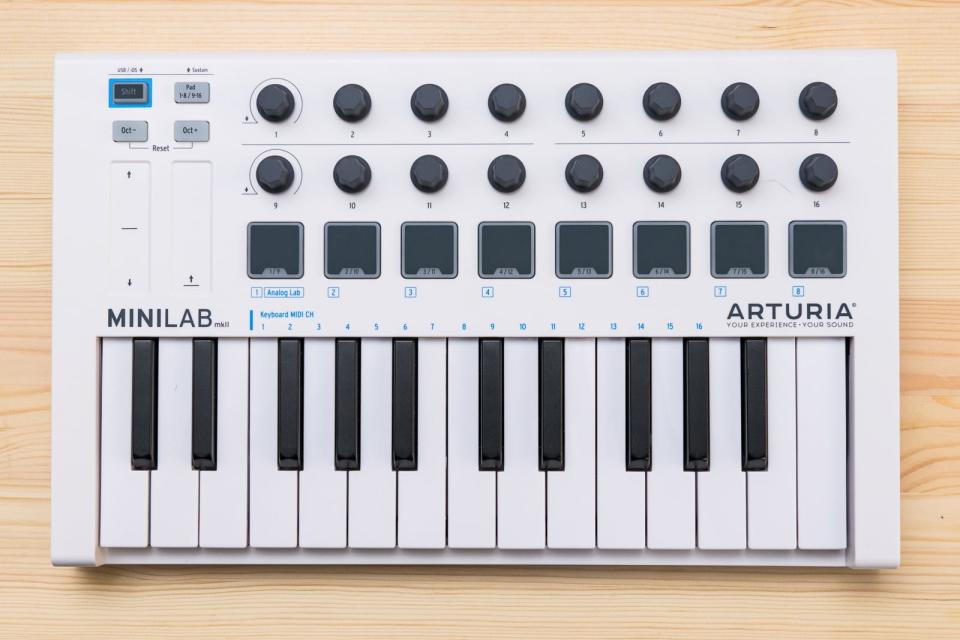
The Arturia MiniLab MkII was an easy choice to make as the best 25-key MIDI controller for most people. At just over 12 inches wide and 8½ inches deep, it's compact enough to sit comfortably on desktops alongside a computer and other gear. With a heavy-duty case braced by a metal bottom plate that adds heft and stability, its build quality is several notches above that of the other controllers in our test group. The Arturia's uncluttered layout, with well-spaced rotary knobs and pads and only a minimum of extra controls, also makes it an approachable option for electronic-music newbies, as well as a good choice for advanced musicians seeking a streamlined controller for live performance.
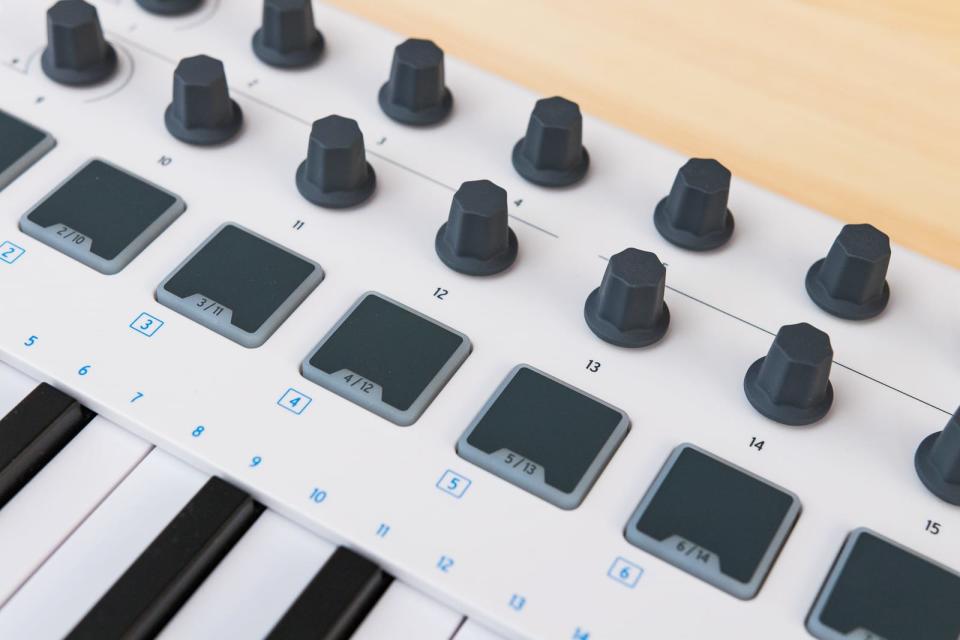
The MiniLab MkII may be compact and basic compared with some of the other controllers we looked at, but its features are well-chosen. With 16 rotary knobs, the Arturia model offers twice as many controls as the competition, letting you tweak more parameters simultaneously on DAWs and software instruments, such as high- and low-pass filters (similar to tone controls) and levels. Its eight color-backlit velocity-sensitive pads are lined up in the center of the controller, easily accessible for finger-drumming. A shift button lets you switch between two banks, bringing the total number of pad assignments to 16.
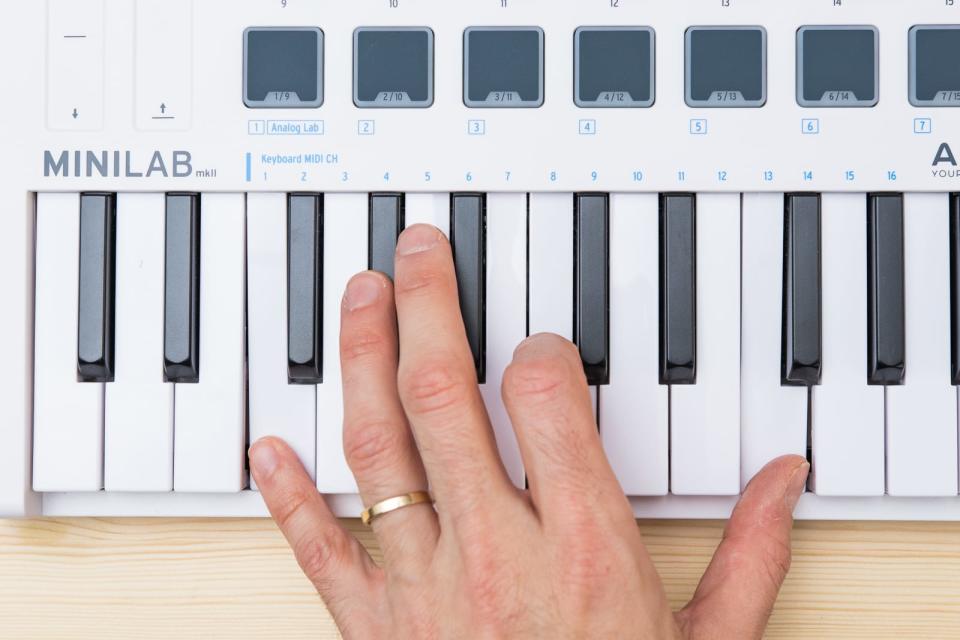
While the Arturia controller's mini synth-action keys are more challenging to play than full-size keys, Denis Kitchen found them to be responsive, with good key velocity right out of the box, making it easy to get a natural range of soft to loud sounds from pianos and other plug-in instruments. The pads were also responsive, providing a good feel and a decent enough velocity for us to get dynamic effects when we were drumming.

The MiniLab MkII is configured to automap its controls to a range of popular DAWs including Ableton Live, and it comes with an excellent software plug-in bundle consisting of Arturia's Analog Lab Lite and UVI Grand Piano instruments. Automapping lets you browse presets for those instruments using the MiniLab MkII's rotary knobs, which makes scrolling through and searching the 500 available sound patches in Analog Lab Lite a breeze.
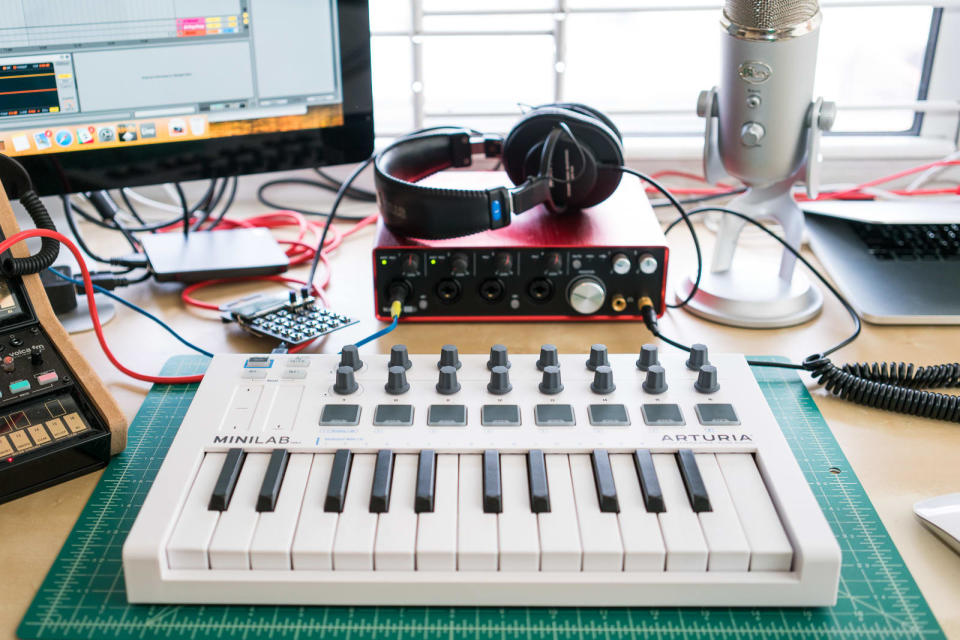
Other reviewers share our enthusiasm for the MiniLab MkII. Writing in Keyboard magazine, Francis Prève notes: "As a reviewer, I've played more than my share of portable controllers, and the MiniLab MkII's mini keyboard feels better than most of its competitors. I was immediately impressed by the action, as well as the velocity behavior, especially in conjunction with the included UVI Model D Grand Piano." Wrapping up an overwhelmingly positive review of the MiniLab MkII, Ask.Audio's Matt Vanacoro concludes, "[Once] you try it, just about anything else in the price/build class feels like a toy." The overall rating on Amazon at the time of this writing was 4.7 out of five stars across 19 reviews.
Flaws but not dealbreakers
While we found the MiniLab MkII highly playable for a compact controller with mini keys, serious keyboard players are likely to prefer models with full-size keys. In addition, the response of Arturia's capacitive pitch-bend and modulation control strips was slow in our testing, making them a less-than-ideal option for live performance. Finally, although the MiniLab MkII's 16 rotary knobs are a welcome feature, some people might like a few fixed knobs for functions (such as volume) that they might want to set to either end of the range by feel, though that's a matter of personal preference.
Runner-up: Nektar Impact LX25+
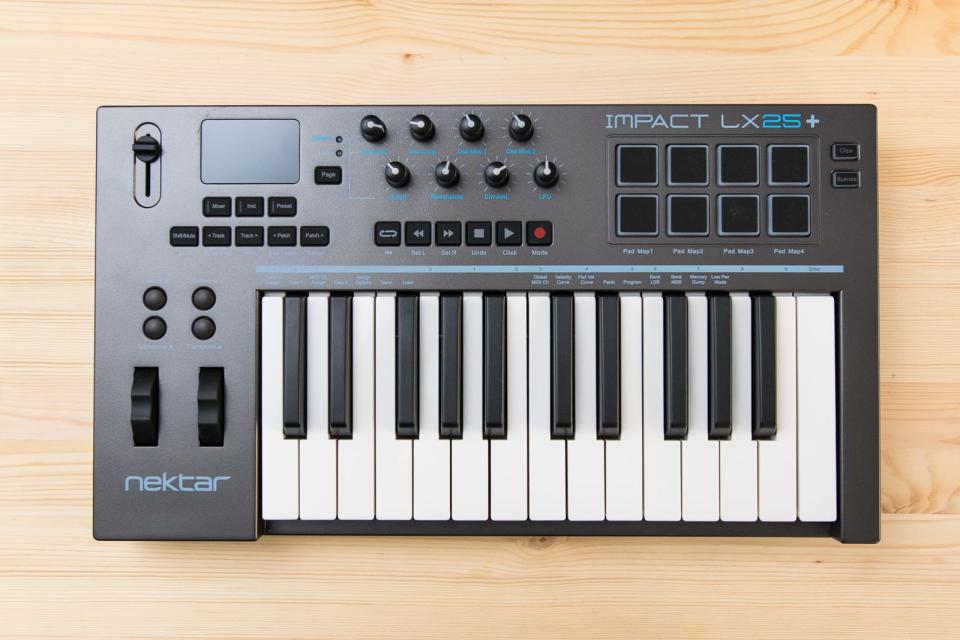
Typically priced about the same as our main pick, the Nektar Impact LX25+ has full-size keys that should appeal to seasoned keyboard players seeking a compact controller to use for live performance. Its comprehensive MIDI feature set also makes it a good option for people who want to dive deep into configuring the controller.
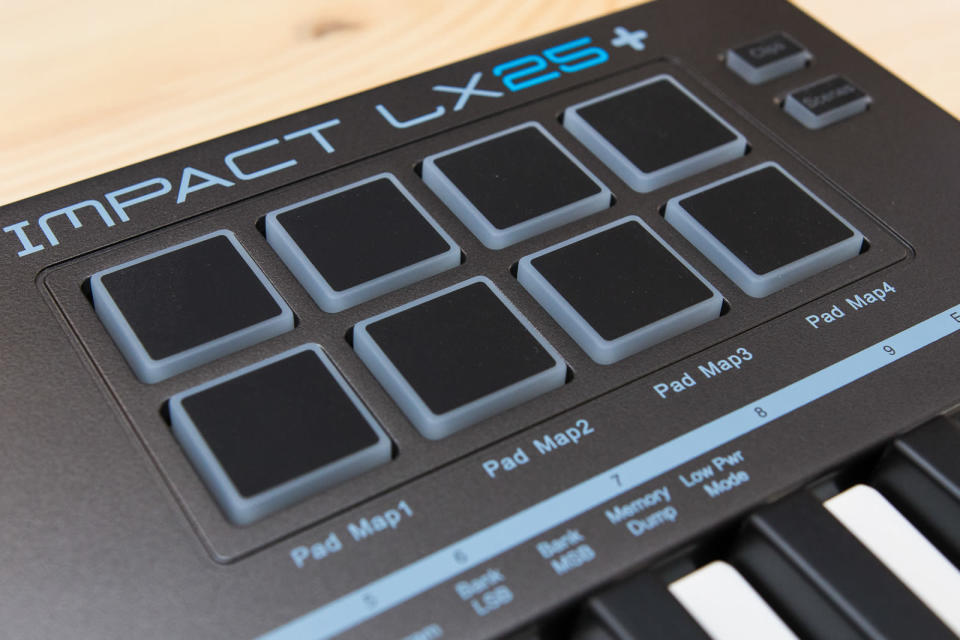
To that end, the Impact LX25+ features an LED display that provides visual feedback such as the active keyboard octave range during setup and configuration, which you can carry out on the controller itself as opposed to using a separate software application and then porting the results over. It also offers a full set of transport keys to control DAW functions such as record, playback, and looping, so you don't have to shift back and forth between the controller and your computer when creating tracks.
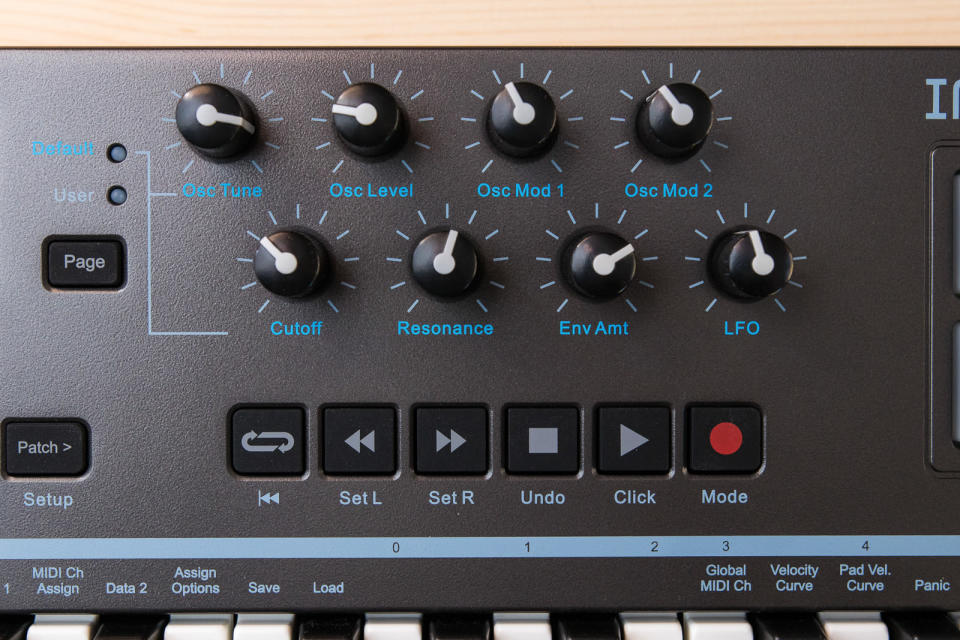
The Nektar distinguished itself in our testing through its keyboard feel—the keys had good action and velocity right out of the box. Its rubber-coated pitch and modulation wheels were also easy to handle and offered a decent level of tension, making them a good option for performance. Tapping out beats was a pleasure with this model's rubbery, responsive, comfortably spaced 1-inch pads at the top-right section of the controller.
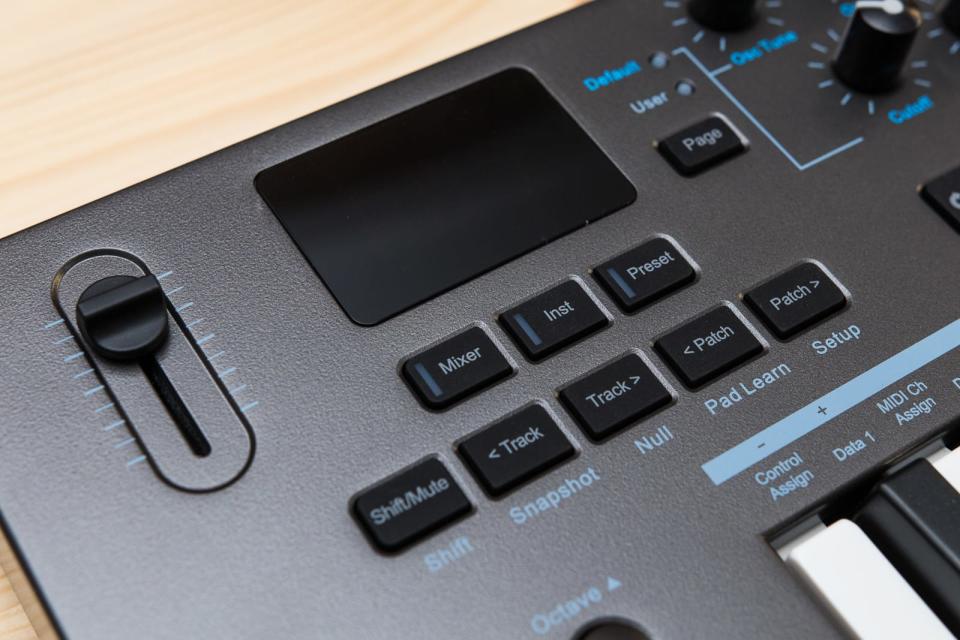
Areas where the Impact LX25+ came up short included its rotary knobs, which had a looser feel and less resistance than those on the Arturia, M-Audio, and Alesis controllers. It also doesn't come with a download code for Ableton Live Lite, though Nektar does provide a free copy of Bitwig 8-Track, a full-featured DAW similar to Ableton's Live. It's a newer piece of software, so it might be unfamiliar to people with some experience, but it has a clear layout of functions, and beginners shouldn't have any more difficulty getting into music making with this package than they would with more venerable software.
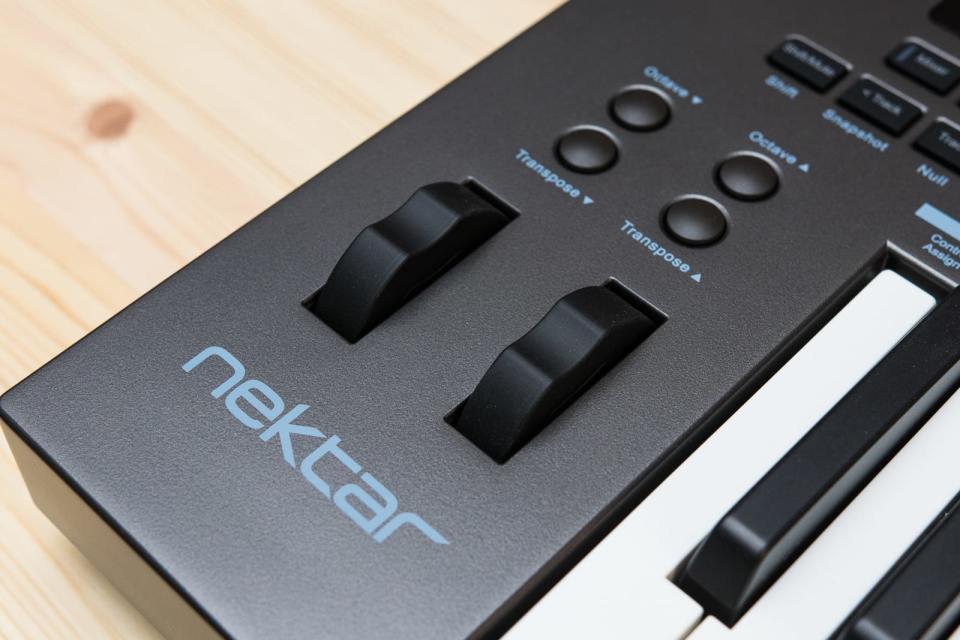
Automapping for Live isn't available when you first fire up the Nektar controller, though a document on the company's support site will guide you through configuration for use with the program. During my testing, I was able to use the Impact LX25+ to easily control many features of another DAW, Apple's GarageBand, with only minimal setup.
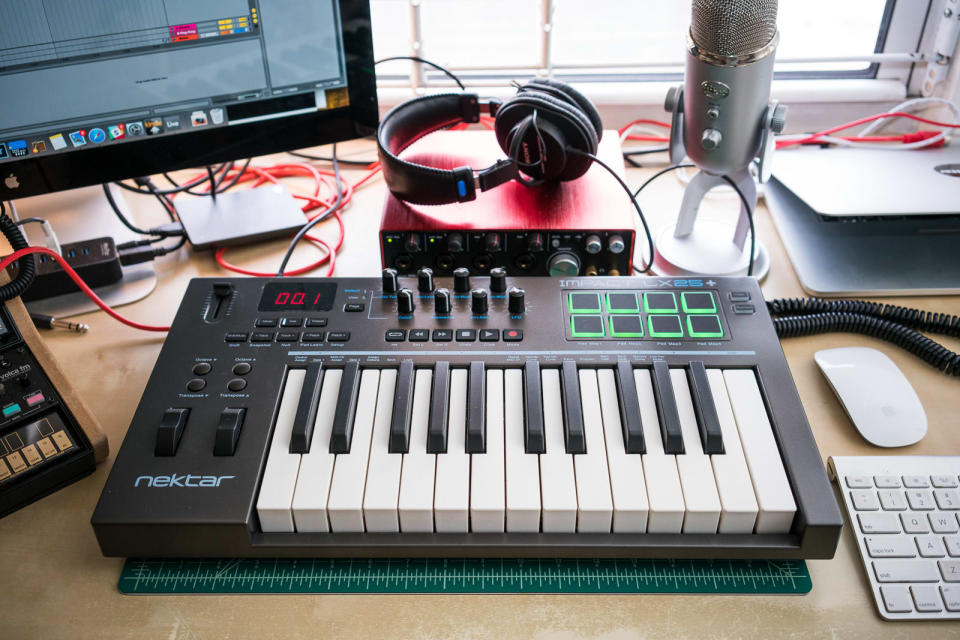
Writing on MakeBeats101, the site's chief reviewer Carlo homes in on the Nektar's onboard MIDI adjustments, noting, "The controls is where the Impact LX25+ really shines. I have never used a keyboard which is as intuitive as this when it comes to controlling your DAW from your fingertips without ever needing to reach for your mouse." Last time we checked, the Impact LX25+ had earned an overall rating of 4.8 out of five stars across 24 reviews on Amazon.
Also great: Akai MPK Mini MKII
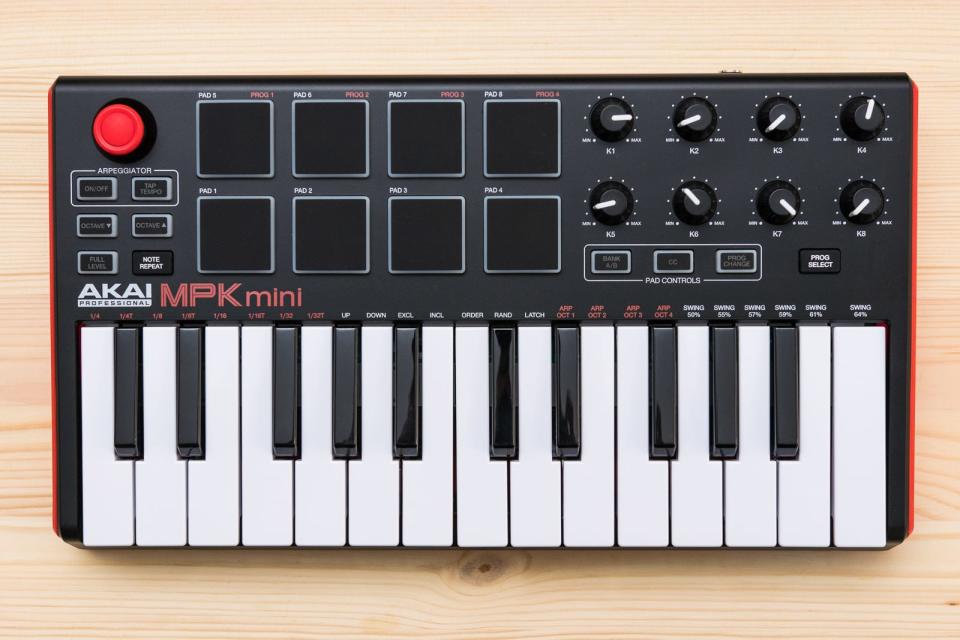
The Akai MPK Mini MKII is an even more compact option than the Arturia MiniLab MkII, and it offers a few key features not found on that controller. The main one is its set of large, 1⅛-inch drum pads—the same size as the pads on the comparatively gargantuan M-Audio Oxygen 25. Not only are the Akai's pads big, but they are also spaced wide enough to enable comfortable playing, and they have a good feel and responsiveness.
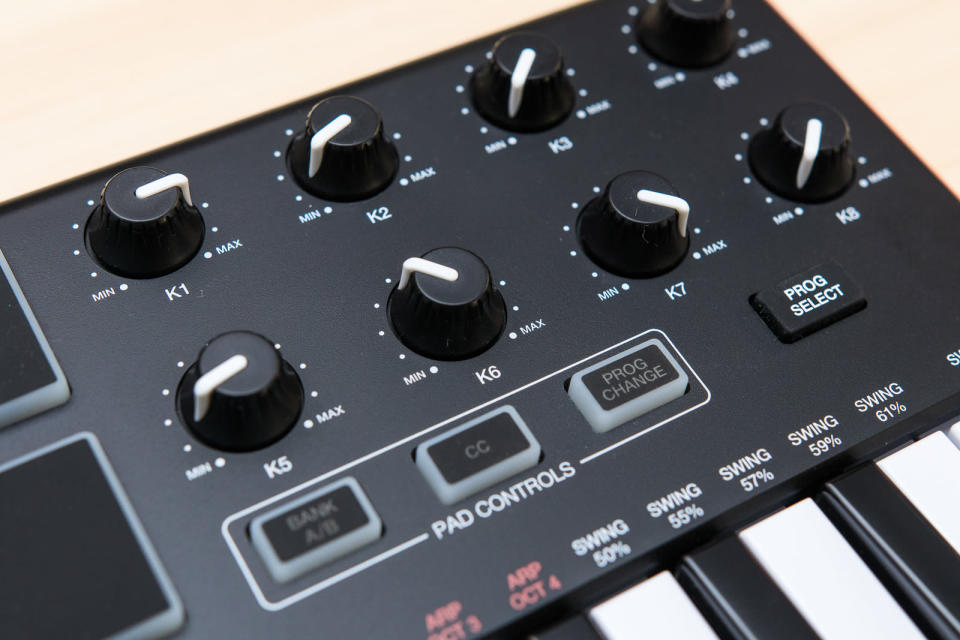
In our keyboard tests, the MPK Mini MKII's pitch-bend and modulation thumb stick also worked surprisingly well, making this model a decent option for live performance, where pitch-bend and modulation controls are important for getting an authentic keyboard sound. The built-in arpeggiator lets you tap out repeating patterns quickly, so you can effortlessly achieve a warbly Stranger Things soundtrack effect.
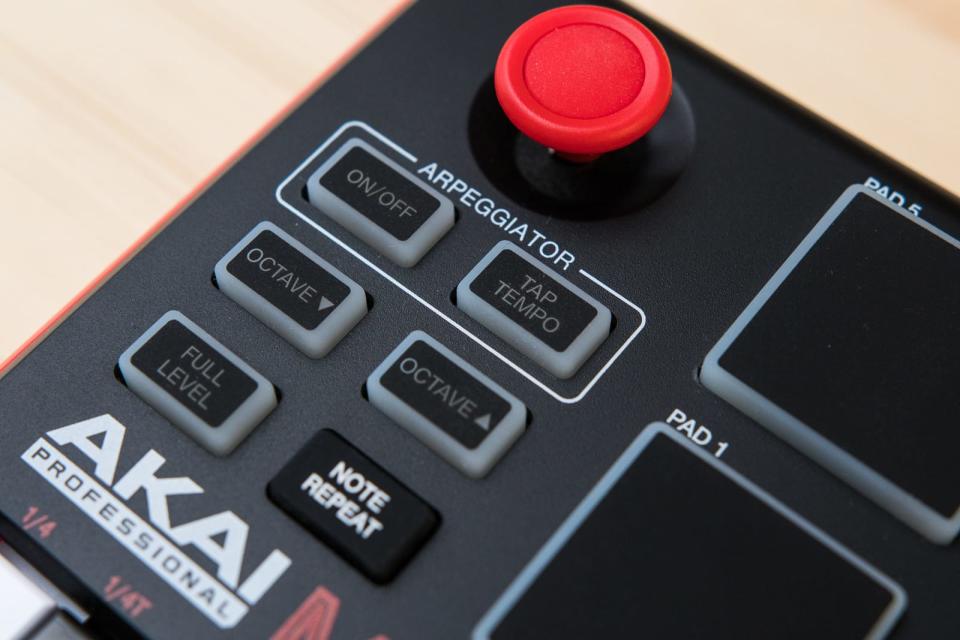
Finally, Akai bundles its controller with an impressive software package, including the Sonivox Wobble and Air Hybrid 3 plug-in instruments, and Akai's own MPC Essentials DAW and MPK Mini MIDI Editor.
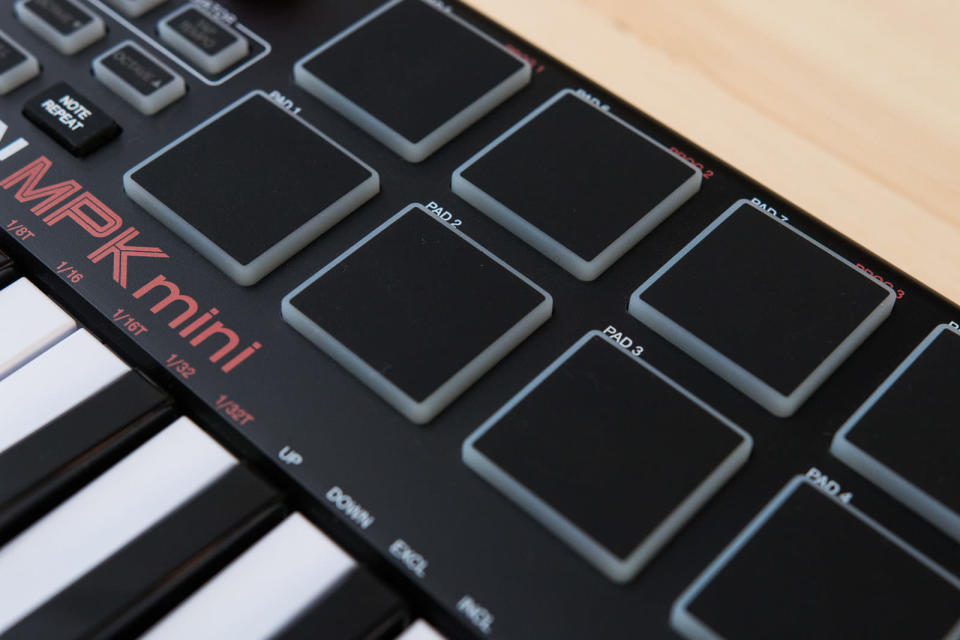
While the MPK Mini MKII is a great option for making beats, its small keys—the smallest of any controller we tested—can make playing keyboard leads a challenge, especially if you have thick fingers. Its keys also had a stiff response in our tests ("Stiff as hell," according to Denis Kitchen), although the velocity response was good out of the box. In addition, the Akai's eight rotary knobs are small and somewhat flimsy, offering very little resistance when twisted.
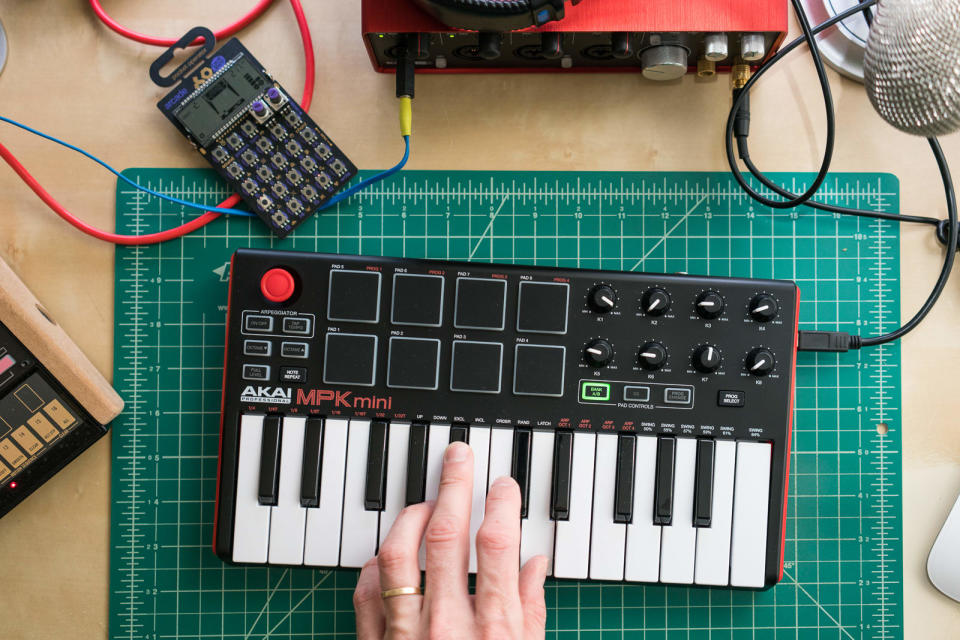
A reviewer for The Wire Realm had a positive experience testing the Akai, citing its generally good build quality and pad performance, which is "great for what you pay for." The reviewer also characterizes its thumb-stick control as being "great to get some custom and significantly swingy, more natural sounding pitch and modulation down to your tracks." At our last check, across 1,194 reviews, the MPK Mini MKII had an overall rating of 3.9 stars out of five on Amazon.
The competition
The Novation Launchkey Mini 25 MK2 was created for use with Ableton Live, and it works exceptionally well as a control interface when paired with that program. It gives you buttons designed specifically to navigate tracks and scenes in Live, and the controller's 16 pads can trigger samples, with RGB backlighting to indicate status feedback. As an input device or general-purpose MIDI controller, however, the Novation is less useful: In our tests, the keyboard action proved just marginally better than that of the Akai MPK Mini MKII, and the tiny (¾-inch square), closely spaced pads were an ergonomic nightmare for drumming. On the plus side, the Launchkey Mini 25 MK2 comes bundled with Novation's excellent V-Station and Bass-Station software instrument plug-ins.
"An interesting exercise in minimalism" is how Denis Kitchen characterized the Alesis V25 after first having a go at it. By combining full-size keys with a stripped-down control set consisting of eight pads, four rotary knobs, and four programmable buttons, the V25 presents a clean layout that some people will find appealing. It's also the least expensive model we looked at. During testing, however, we found the action of the keys to be stiff compared with that of the Nektar and M-Audio controllers; the velocity settings (which you need to configure using an editor app on your computer) were also just marginally acceptable, and the pitch-bend and modulation wheels were small and awkwardly placed. And while the V25's build quality is generally sturdy, the bottom was warped enough that our review unit wouldn't sit flat on a desk—an obvious quality-control issue.
The M-Audio Oxygen 25 MKIV has full-size keys and a feature set as extensive as that of the Nektar Impact LX25+. In our tests, the action of the semi-weighted keys was responsive, and its rubber-coated rotary knobs provided a solid level of resistance. The pitch-bend and modulation wheels on the M-Audio also work well for performance, though they lack the rubber coating and responsiveness of the ones on the Nektar. The Oxygen 25 MKIV's out-of-the-box velocity proved overly aggressive, however, and we couldn't find an alternate preset that provided satisfying dynamic range when playing. Also, its pads had poor response, with sensitivity focused mainly at the pad's center.
What to look forward to
Since our last update, a few new MIDI controllers have caught our eye for consideration in our next update. The Korg NanoKey has dropped in price, now coming in well under our price cap. The Worlde Tuna Mini has an attractive design and a lower price than most 25-key controllers. The Worlde Panda Mini is similar, with a more basic-looking design and lacking the slider pitch-bend controls, but it is a little cheaper.
This guide may have been updated by Wirecutter. To see the current recommendation, please go here.
When readers choose to buy Wirecutter's independently chosen editorial picks, Wirecutter and Engadget may earn affiliate commissions.
